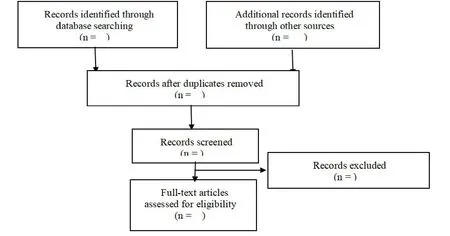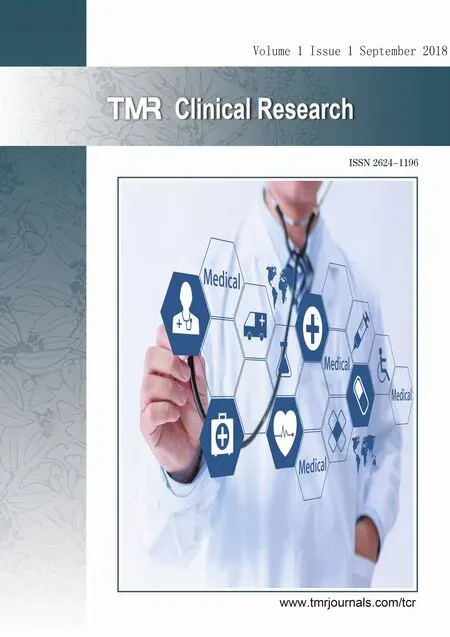The Chinese herbal Formula Tongxieyaofang for irritable bowel syndrome:a protocol for meta-analysis of randomized controlled trials
Cuncun Lu,Zhijiang Bi,Kongyuan Wei,Zhaochen Ji,Long Ge,Kehu Yang*
1Evidence-Based Medicine Center,Lanzhou University,Lanzhou,73000,P.R.China;2Key Laboratory of Evidence-Based Medicine and Knowledge Translation of Gansu Province,Lanzhou,73000,P.R.China;3The GRADE Center in China,China;4School of Basic Medical Sciences,Lanzhou University,China;5Gansu University of Traditional Chinese Medicine,China;6The First Clinical Medical College,Lanzhou University,China;7Centre of Evidence-Based Medicine,Tianjin University of TCM,China.
Introduction
Irritable bowel syndrome(IBS),themost common functionalgastrointestinaldisorder[1],isa chronic functional bowel disorder characterized by abdominalpain andaltered bowel function[2].Itis estimated about more than10%-25%ofthegeneral populationwithIBS inaround theworld[3].The IBSisdiagnosedusingthe Romecriteria[4].The high cost for patientswith isa greatburden bothfor the family and society[5].Atpresent,lifestyle modification and some western medicine,for example,antispasmodics and probiotics,arethe main therapy forIBS[5-6],but theireffectsare not satisfactory.With theadvent ofevidence-based medicine [7],traditionalChinese medicine is getting more and morepopular,anditshows some advantages.TheTongXieYaoFang(TXYF)is a Chinese herbalformula for themanagement of chronicdiarrhea accompanied by abdominalpain withnearly 600 years[8].Therefore,traditional Chinesemedicine doctors always treat IBS using TXYF.But,animalstudies andclinicaltrials showed inconsistent resultson its effectiveness.Althoughthereare severalsystematic reviews[9-10]were published, they concluded that their conclusionneeds to beconfirmedbecause ofthe qualityof included studiesandvarietyin itsclinical effect across the trials.And,recently,relevant primarystudy[8]with lager sample size(N=155)is published.Therefore,a newsystematicreview and meta-analysisshould beconducted to summary evidenceon the safety and eectivenessof TXYF for IBS.
Methods
Eligibilitycriteria
Typesofstudies.Randomized controlled trials(RCTs)that investigated the effect of TXYF for the treatmentof Irritable bowel syndrome(IBS)will be included without language limitation.
Types of participants.PatientswithIBS and allof themshould beadults(age≥18),which should be confirmedaccordingtothe any types of Rome criteria[4,11-12].There arenolimitations in gender,race,or nationality.
Types ofinterventions.Interventionsof any form of TXYF compare with another therapiesare eligible,including decoction or tablet.
Typesof outcome measures.Theprimary outcome isthe disappearanceor significantimprovement in global symptoms, including abdominal pain,diarrhea,constipation,and abdominal distention etc.Thesecondary outcomesincludingvisual analog scale (VAS) score, adverse event,rehospitalization rate and the quality of life.RCTs reporting on at least one above situation will be included.
Data source.Seven electronic databases,including PubMed,EMBASE,the Cochrane library,CNKI,WanFang,VIP and CBM databaseswillbe searched from inceptions to July 2018.There was no language restriction in this study.The Search strategy of PubMed was as follows:
#1"TongXieYaoFang"[Title/Abstract]OR"TXYF"[T itle/Abstract]
#2 "Colonic Diseases"[Mesh] OR "Colonic Diseases,Functional"[Mesh]OR"Irritable Bowel Syndrome"[Mesh]ORirritablebowel[Text Word]OR irritablecolon[TextWord]ORspastic colon[TextWord]ORfunctionalboweldisease*[Text Word]OR functionalcolonicdisease*[Text Word]OR Mucous Colitis[Text Word]
#3"RandomizedControlledTrial"[Publication Type]OR "Randomized Controlled Trialsas Topic"[Mesh]OR random*[Title/Abstract]
#4#1AND#2 AND#3
Studyselection and informationextraction.The EndNote X7 software will be used to manage citations from electronicdatabases.First,two reviewers(BZJ and WKY)will independently check all of titles and abstracts of each record according to eligibility criteria,but,if there are some studies cannot be determined,the third reviewer will be asked to make a decision(Figure 1).The potentially relevant studies also will be identified for further assessment to ensure all available studies are included.The Microsoft Excel 2016 will be used to collect relevant information and data.The extracted information,including first author, year of publication, sample size,intervention,and outcome will be extracted from each study and entered into the spreadsheet of Microsoft Excel 2016.
Quality assessment.Quality assessment will be conducted by 2 independent reviewers(JZC and GL).Disagreement will be resolved by discussion or consultation of Kehu Yang or Cuncun Lu.The currently recognized risk of bias Tool in Cochrane Handbook 5.1.0[13]will be used to assess the potential risk of bias(ROB)of included RCTs,and the tool including seven items:random sequence generation,allocation concealment,participant and personnel blinding,outcome assessment blinding,incomplete data,selective reporting,and other biases.Every item in ROB will be categorized as low risk,unclear risk,or high risk.
Statisticalanalysis.Head-to-head meta-analyses will be performed usingrandom-effect orfixedeffect modelby theCochraneCollection’stool RevMan 5.3 software.Relativerisk(RR)with95%confidence interval(95%CI)willbe presented for dichotomous data(effectiveness and adverse event).Continuous data(VAS score)will be reported as conducted to assess the potential heterogeneity across the included studies.Sensitivity analyses will be performed to investigate the source for potential heterogeneity(I2>50%,P<0.1)and mainly according to the methodological quality and sample size.Subgroup analysiswillalso be performed according to evaluation time periods.The funnel plot will be used to explore the publication bias when there are at least 10 studies be included in this meta-analysis[14-15].weighted mean difference(WMD)with 95%CI.The I2test will be
Qualityof evidence.The quality of evidence for the primary outcome willbe assessed using the Grading of Recommendations Assessment,Development and Evaluation[16],which including 4 levels:high level,moderate level,low level,and very low level.Flaws in five aspects,including study design, inconsistency, imprecision,indirectness,and publication bias.

Figure 1 Flow of study identification,inclusion and exclusion(PRISMA 2009)
Statisticalanalysis.Head-to-head meta-analyses willbeperformedusing random-effector fixedeffect model by the CochraneCollection’s tool RevMan 5.3 software.Relativerisk(RR)with 95%confidence interval(95%CI)willbe presented for dichotomousdata(effectivenessandadverse event).Continuous data(VAS score)will bereported as weighted mean difference(WMD)with 95%CI.TheI2testwillbe conductedto assess thepotential heterogeneity across the included studies.Sensitivity analyses will be performed to investigatethe sourcefor potentialheterogeneity(I2>50%,P<0.1)andmainlyaccording to the methodological qualityandsample size.Subgroup analysis will also beperformed according to evaluationtime periods.Thefunnel plot will be used toexplore the publicationbiaswhen there are atleast 10studies be included in thismeta-analysis[14-15].
Quality ofevidence.Thequalityofevidence for theprimaryoutcome willbeassessed using the Grading of Recommendations Assessment,DevelopmentandEvaluation[16],which including 4 levels:high level,moderatelevel,lowlevel,and very low level.Flawsinfive aspects,including study design, inconsistency, imprecision,indirectness,and publication bias.
Discussion
This systematicreview and meta-analysis will summarize the evidence on the safety and eectivenessoftheChineseherbal medicine TongXieYaoFangforIBS.Tothe best of our knowledge,although there are several similar studies[9-10]included smallersample sizetrials werepublished,they thoughtthat their conclusion needstobeconfirmedbecauseof the qualityof includedstudiesandvarietyinits clinical effect across the trials.Moreover,relevant new study[8]was published with a lager sample size(N=155)and low risk of bias.Therefore,this study will be conducted to coverthe shortageand provide clinical recommendation for patients with IBS in Chinese medicine clinical practice.
This protocol is designed in line with the commonly recognized guideline for systematic review and meta-analysis protocol[17]and will be performed and reported strictly according to the PRISMAstatement[18].
Ethical issues
Ethicalapprovaland patientconsentarenot required since this is ameta-analysis basedon published or unpublished studies.
Conflicts of interest
We declare that we have no conflicts of interest.
1. Singh R,Salem A,Nanavati J,et al.The Role of Diet in the Treatment of Irritable Bowel Syndrome: A Systematic Review.Gastroenterology Clinics of North America 2018,47:107-137.
2. HenströmM,Diekmann L,Bonfiglio F,et al.Functionalvariantsinthesucrase-isomaltase geneassociatewith increasedriskofirritable bowel syndrome.Gut2018,67:gutjnl-2016-312456.
3. Kennedy P J,CryanJF,DinanTG,et al.Irritable bowel syndrome:Amicrobiome-gutbrain axis disorder? World Journal of Gastroenterology 2014,20:14105-14125.
4. Drossman D A,HaslerWL.RomeIVFunctional GIDisorders:Disordersof Gut-Brain Interaction.Gastroenterology2016,150:1257-1261.
5. GweeKA,Ghoshal UC,Chen M.Irritable bowel syndrome inAsia:pathogenesis,natural history, epidemiology and management.JournalofGastroenterology& Hepatology 2018,33.
6. Moayyedi P,Ford A C,Talley N J,et al.The efficacy of probiotics in the treatment of irritable bowel syndrome:a systematic review.Gut 2010,59:325-332.
7. Chen YL,Zhao C,Zhang L,et al.Toward Evidence-Based Chinese Medicine:Status Quo,Opportunities and Challenges.Chinese Journal of Integrative Medicine 2018,24:163-170.
8. Chen M,Tang TC,Wang Y,et al.Randomised clinicaltrial:Tong-Xie-Yao-Fang granules versus placebo for patients with diarrhoeapredominant irritable bowel syndrome.Alimentary pharmacology & therapeutics 2018;48:160-168.
9. Bian Z,WuT,LiuL,et al.Effectivenessof the Chineseherbal formulaTongXieYaoFang for irritablebowel syndrome:asystematic review.JournalofAlternative & Complementary Medicine 2006,12:401-407.
10.ChengCW,Bian ZX,WuT X.Systematic review of Chinese herbalmedicine for functionalconstipation.World Journalof Gastroenterology 2009,15:4886-4895.
11.Badia X,MearinF,Balboa A,etal.Burdenof illnessinirritablebowelsyndrome comparing Rome I and Rome II criteria.Pharmacoeconomics 2002,20:749-758.
12.Zhang M,ChenM,Peng S,etal.The Rome IV versusRomeIII criteriaforheartburn diagnosis: A comparative study. United European Gastroenterol J 2018:358-366.
13.Higgins JPT,Altman DG,Sterne JAC.Chapter 8:Assessing risk of bias in included studies.In:Higgins,J.P.T.,Green,S.,editors.Cochrane Handbook for Systematic Reviews of Interventions version 5.1.0(updated March 2011):The Cochrane collaboration.Available from www.chochrane-handbook.org.2011,pp.243-296.
14.Egger M,Davey Smith G,Schneider M,et al.Bias in meta-analysis detected by a simple,graphical test.BMJ 1997,315:629-634.
15.Harbord R M,HarrisR J,Sterne J A C.Updatedtestsfor small-study effects inmetaanalyses.Stata Journal 2009,9:197-210.
16.Guyatt G H,OxmanA D,Vist G E,etal.GRADE:anemerging consensus on rating quality of evidence and strength of recommendations.BMJ 2008,336:924–926.
17.ShamseerL,MoherD,Clarke M,etal.Preferred reporting items for systematic review andmeta-analysisprotocols(PRISMAP)2015:elaboration andexplanation.BMJ 2015;349:g7647.
18.MoherD,Liberati A,TetzlaffJ,etal.Preferred reporting items for systematic reviews and meta-analyses:the PRISMA statement.PLoS medicine 2009,6:e1000097.
 Clinical Research Communications2018年1期
Clinical Research Communications2018年1期
- Clinical Research Communications的其它文章
- Literature on the law of Miao medicine in treating liver cancer
- Efficacy and safety of Danhong injection in the treatment of arteriosclerosis obliterans:a meta-analysis of randomized controlled trials
- One patient of hepatic veno-occlusive disease with an increased cancer antigen-125 expression caused by misuse of Sedum aizoon
- TMR Clinical Research:a clinical reference journal for traditional medicine physicians
